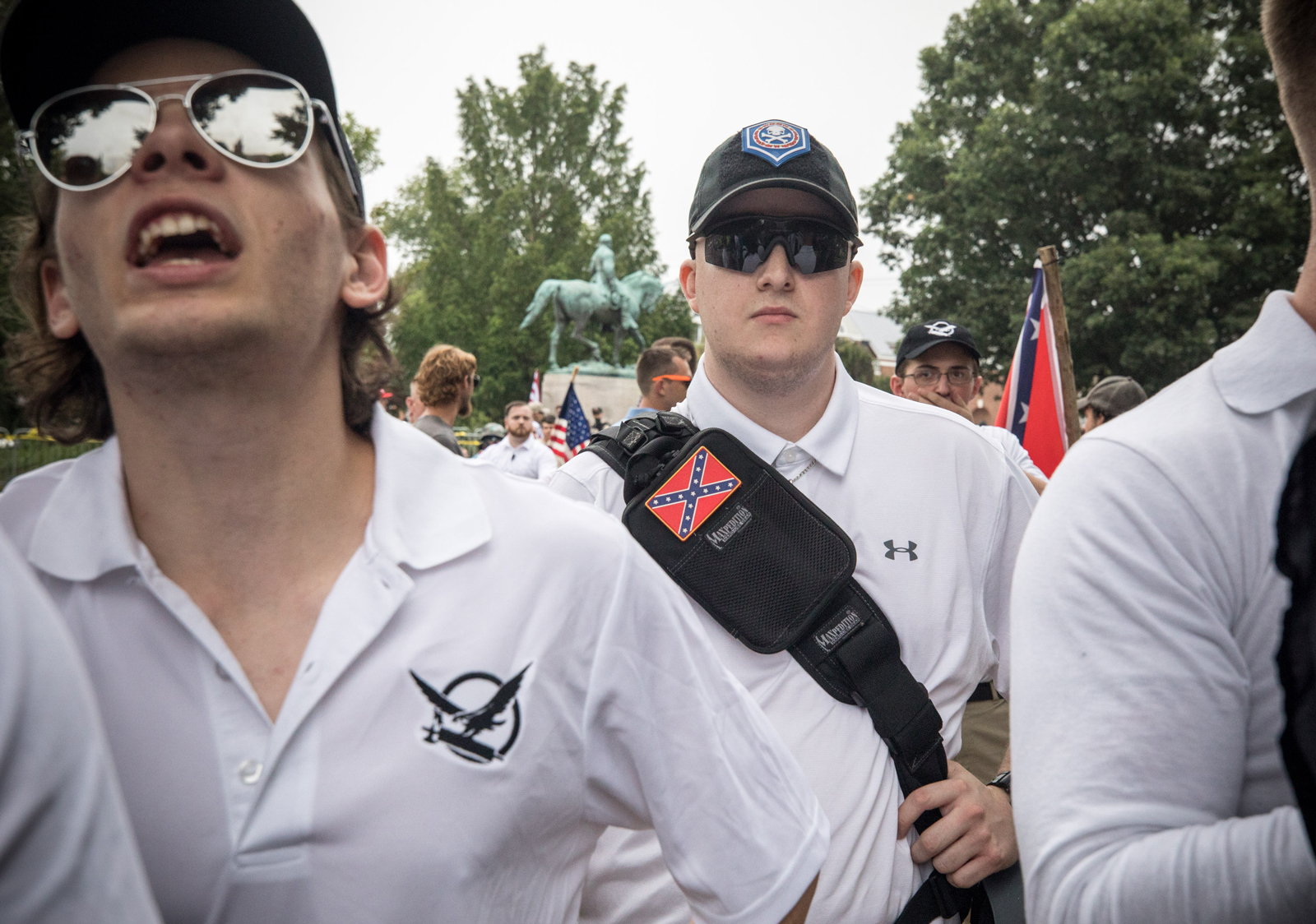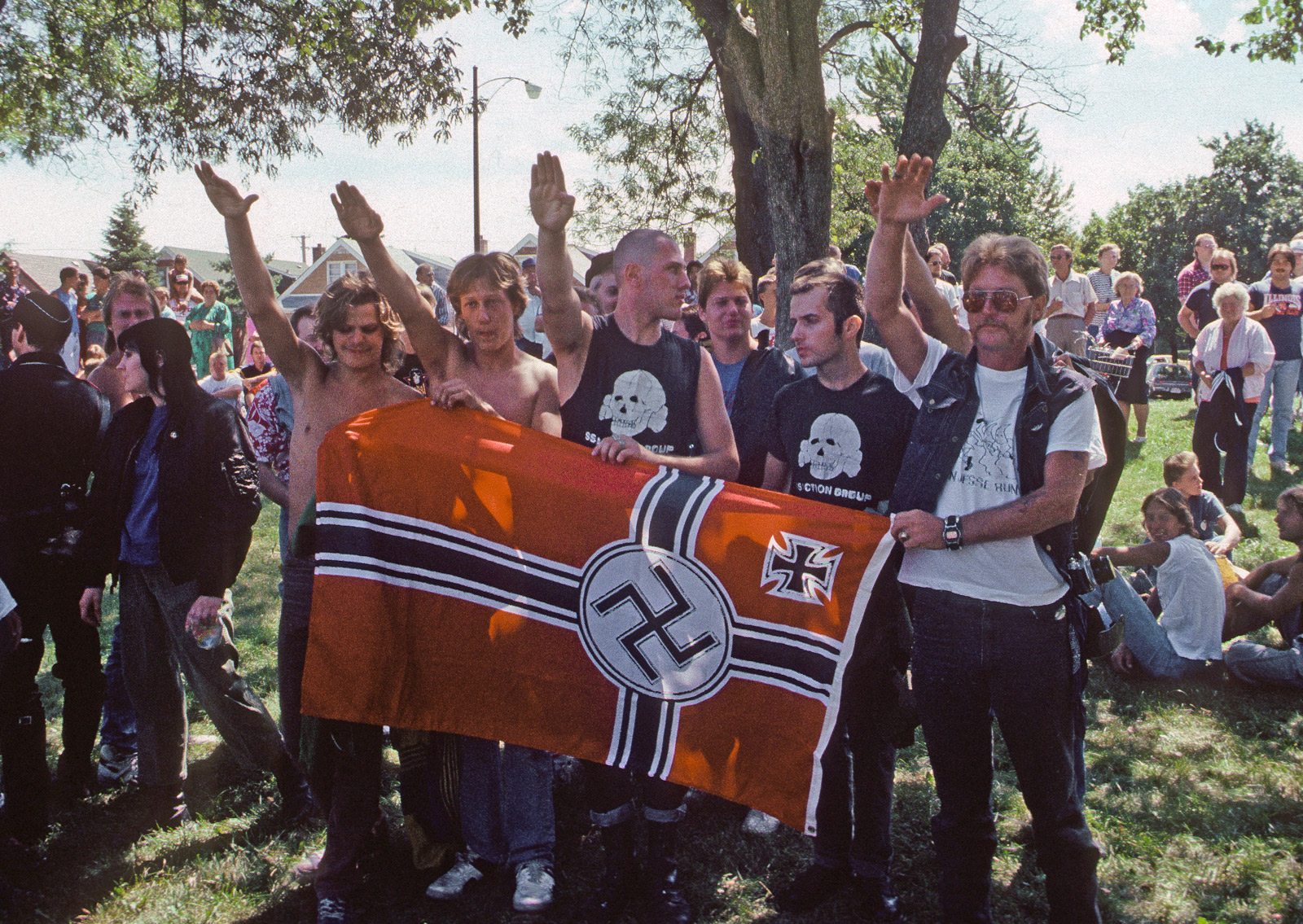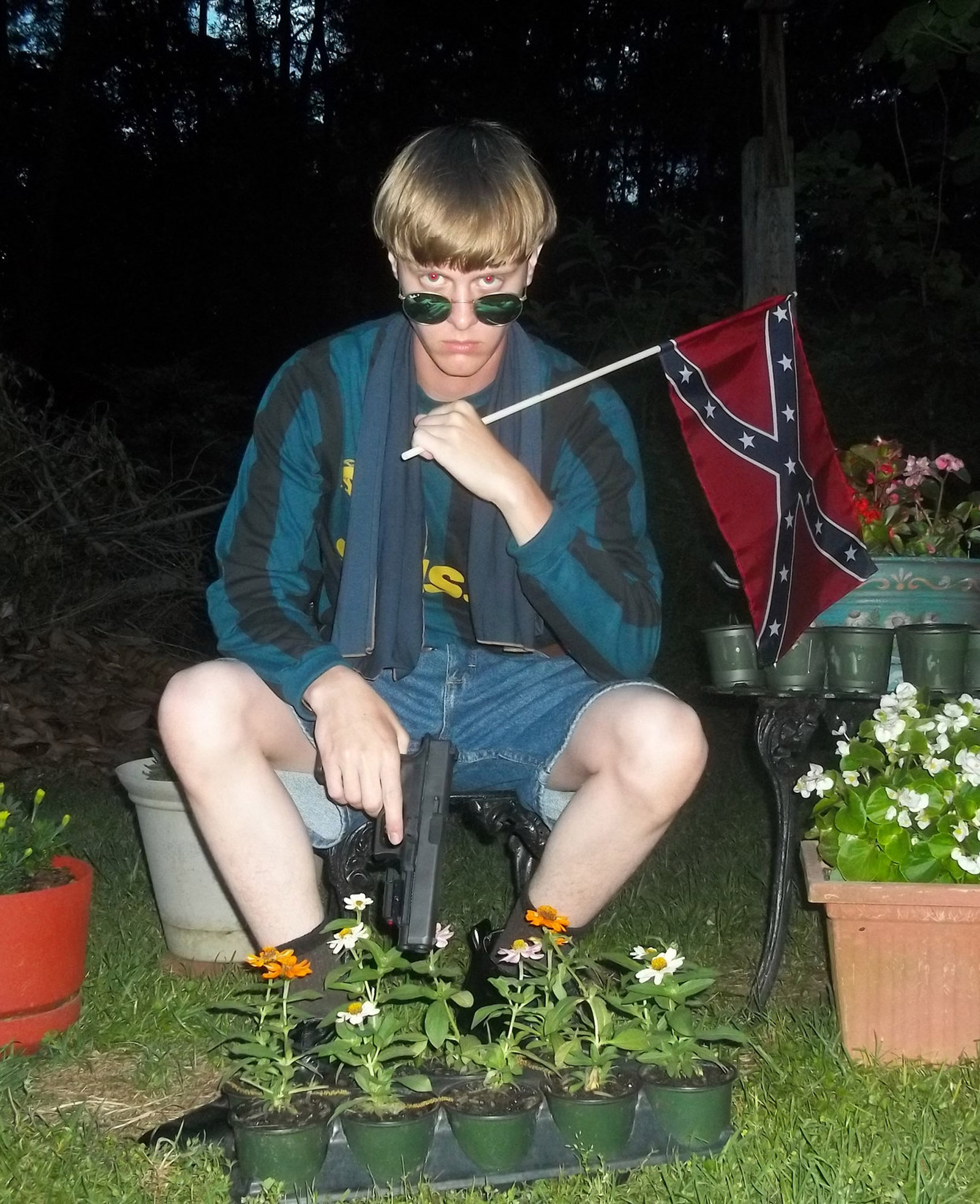Imagine hordes of young men descending on city streets waving flags with mystical symbols, chanting angry slogans, and spouting vicious conspiracy theories about Jews dominating the world. These young militants adhere to an absolutist ideology that invokes a mythic past when their tribe reigned supreme, untainted by corruption and foreign impurity. You might think I’m describing a scene from somewhere in the Middle East. But last year, it was Charlottesville, Virginia. Last weekend, it was Washington, D.C.
On Sunday, a few dozen members of Unite the Right gathered in the nation’s capital for a rally to “protest civil rights abuses in Charlottesville,” the site of their assembly last year, which was marked by deadly violence. Their ranks included neo-Nazis, neo-Confederates, white supremacists, white nationalists, and would-be paramilitaries of the “alt-right,” the innocuous-seeming term these groups have mostly succeeded in getting applied to their old forms of violent hate. What unites this version of the far right is a shared belief that white people are victims, threatened by a growing non-white demographic that threatens to render them powerless.
“Any violent extremism narrative requires a sense of oppression to function,” Arno Michaelis told me. “Unless you can convince yourself you’re oppressed, you can’t be angry enough to hurt people.” Michaelis is a former white supremacist turned anti-hate activist and the co-author of The Gift of Our Wounds: A Sikh and Former White Supremacist Find Forgiveness After Hate (2018). These groups, Michaelis says, often operate with a central belief that “if we don’t fight for it, it will be taken from us,” whatever the “it” may be—power, masculinity, America itself.
Last year in Charlottesville, these extremists dressed to present themselves as your normal, preppy Nazis who shop at Abercrombie & Fitch and Banana Republic outlet stores. They paired polo shirts and tiki torches with swastikas, Confederate flags, shotguns, and rifles—and, in many cases, fashionable side-fade haircuts. “We realized we were turning away the average American white racist if we were too edgy,” says Christian Picciolini, a former skinhead and co-founder of Life After Hate, a group involved in “deradicalizing” white supremacists and countering hateful narratives. “We had to normalize how we looked, sounded, and pitched our ideas.”
In Charlottesville, DeAndre Harris, a twenty-year-old black man, was beaten by a group of Unite the Right activists, including a man who wore a military-style tactical helmet and carried a large shield. Harris suffered a spinal injury and a broken arm. Later that day, a neo-Nazi from Ohio ran a car into a crowd of counter-demonstrators, killing a thirty-two-year-old anti-racism protester, Heather Heyer. Her murder was described as an act of domestic terrorism by Attorney General Jeff Sessions—in marked contrast to President Trump, who said these violent extremists included “some very fine people” and blamed “both sides.”
If the neo-Nazis had been Muslim demonstrators, the president would doubtless have been quick to label any violence they caused as terrorism. Just a few days before the Charlottesville events, Trump’s then-adviser Sebastian Gorka said that white supremacists and white men were not the problem. “Go to Sinjar. Go to the Middle East, and tell me what the real problem is today. Go to Manchester,” he said, referring to the British city that suffered a suicide-bomb attack by a violent Muslim extremist in May 2017.
Even law enforcement was looking the other way. Just over a week before the Charlottesville rally, the FBI counterterrorism division released a report creating a new term, “black identity extremists,” and identifying them as a growing threat of premeditated violence against the police. But according to Heidi Beirich, who heads the Intelligence Project at the Southern Poverty Law Center, which tracks right-wing extremism, the real threat is white supremacist groups. “From the rise in hate groups, [to] the size of online forums, [and] the readership of webpages, all of these are indicators we have more people thinking this way in recent history,” she told me.
I asked her if there was a hierarchy of hate for these groups. “It’s all people of color,” Beirich replied. “But when it comes our [American extremists], the Jews are always the cabal-ers in the back of the room, because [the extremists] don’t think of people of color are smart enough to run the cabal.” A popular chant at the first Unite the Right rally was “Jews will not replace us.”
Beirich’s assessment is corroborated by Kathleen Belew, a historian at the University of Chicago and the author of the alarming and meticulously researched Bring the War Home: The White Power Movement and Paramilitary America (2018).“We are in an era where we expect to see a rise in white nationalism violence,” she told me. “We are in a moment of rising activity.” 2017 was one of the deadliest years on record for domestic extremist violence since 1970. A recent Anti-Defamation League study found that in the past decade 71 percent of the 387 murders committed by extremists in the United States had been perpetrated by the far right, while Muslims were responsible for 26 percent.
Advertisement
What explains the steep rise and mainstreaming of hate-filled ideologies that until recently existed only on the margins of the Internet and fringes of society?
*
The far right could not have achieved such mainstream influence without an ally in the White House. Since the 2016 election, when many pundits explained Donald Trump’s victory by citing the “economic anxiety” of his white base, that motivator has been exposed as a euphemism for “racial anxiety”—Trump’s Muslim ban, separation of families at the border, and the persistent pattern of his openly racist statements are all popular with the Republican base. Just this week, the president referred to his former adviser, Omarosa Manigault Newman, a black woman, as a “dog.” A diverse and democratically equal society is seen as “a threat to their group’s dominance in our country overall,” says Diana C. Mutz, a political science professor at the University of Pennsylvania and author of a journal study on the 2016 election.
A popular fear of these extremist groups is that white people are being deliberately replaced in a literal and figurative “white genocide.” They believe they are being erased by a growing non-white population, losing their heritage by the removal of Confederate statues, and being culturally displaced by women and people of color. Angela King, a former neo-Nazi and a co-founder with Picciolini of Life After Hate, began her path toward deradicalization after she formed relationships with black inmates in prison. She said that many of the whites she grew up with in Florida believe people of color get special treatment, through programs like affirmative action and their own TV channels. Because they believe that Obama’s presidency ushered in a “post-racial” society, these whites feel slighted and left behind. Who knew BET and Def Comedy Jam had the power to radicalize?
For many white Americans, the Obama presidency itself exacerbated a white power backlash that can be traced back to the 1960s. Kathleen Belew, the author of Bring the War Home, prefers the term “white power violence” because, in her view, “white nationalist” evokes merely an overzealous patriot. Instead, she argues, these individuals are entirely serious about achieving a transnational white nation through violent revolution. Think of it as a globalized white supremacist version of the ISIS caliphate, but with worse food.
Her research suggests that the modern rise of white power politics is rooted in the disillusionment that followed the Vietnam War, when, particularly among veterans and reservists, there were those who felt betrayed by the state and its “fundamental inability to give people what they felt they were entitled to.” Belew says the title of her book Bring the War Home is taken from a popular Klan essay “about using a shared narrative of the Vietnam War to shape violent activism in the United States.” This strand of nationalist resentment was used to mobilize and unite previously disparate groups on the far right, including the KKK, neo-Nazis, and skinheads.
1983 was a pivotal year. Groups and activists spanning the white power movement gathered at the Aryan Nations World Congress held in Hayden Lake, Idaho, and declared war on the state, seeking to overthrow the federal government. Belew says that this new movement of activists had concluded that “revolution was the only option to President Reagan’s moderation because he could not deliver an extreme enough solution.”
Adopting the classic terrorist group model, the white power movement organized itself into cell structures designed to prevent infiltration. Belew describes it as a “broad-based coalition” of groups and activists that included Klansmen, neo-Nazis, radical tax protesters, and followers of white supremacist theologies, which later included skinheads and militia movements.
Americans remember Timothy McVeigh, who bombed the Alfred P. Murrah Federal Building in Oklahoma City on April 19, 1995, killing 168 people in the deadliest domestic terror attack in US history. Often forgotten is that McVeigh was affiliated with the white power movement. Law enforcement agents discovered that he had a copy of the novel The Turner Diaries, which imagines a violent revolution and race war in the United States. It has been described by the FBI as “the bible of the racist right” (though, obviously, the bureau meant to say “Quran”).
According to Belew, the most significant achievement of the 1983 Hayden Lake strategy was to prevent the public and the government from understanding the white power alliance as the cohesive, organized movement it really was and continues to be. By conveying its actions as those of “lone wolves,” “individual actors,” and “madmen,”the white power movement avoids media labeling, public scrutiny, and prosecution as an organized movement with a deliberate strategy and distinct ideology. Today, the basis on which the media label a suspect either a “terrorist” or a “lone wolf” is determined largely by the suspect’s religion and race or ethnicity rather than by the nature of the crime.
Advertisement
Thus Stephen Paddock, who in 2017 shot and killed fifty-eight people in Las Vegas in the deadliest mass shooting in US history, was a “lone wolf.” Even Dylann Roof, who shot and killed nine black people in a Charleston, South Carolina, church in 2015, was called a “classic lone wolf”—though he had posted photos of himself displaying white supremacist regalia. In contrast, Sayfullo Saipov, the Uzbek national who ran down people on a bike path with a truck in New York last year, killing eight, was immediately and unequivocally branded a “terrorist.” A recent Georgia State University study examined news coverage of US terror attacks from 2006 to 2015 and found that when a terror suspect is Muslim, there is nearly four times as much newspaper coverage as when the suspect is white and non-Muslim.
Humera Khan, an expert in preventing and countering violent extremism, reports that emphasizing “mental health issues” and using phrases like “quiet, disturbed man” to describe these violent white men downplay the severity of the threat. “People aren’t perceiving it as domestic terrorism, they’re seeing it as something else.” Mubin Shaikh, a former security intelligence and counterterrorism agent, says the media’s double standard also ends up helping actual Muslim terrorist groups. He cites the recent case of Toronto shooter Faisal Hussain, who had no credible ties to Muslim extremist groups. “They [the media] wanted this Toronto shooting so bad to be an ISIS case,” says Shaikh. “And then ISIS seizes this and claims the attack.”
In 1984, the white power movement started distributing computers to their cells across the country in order to build the movement, connect activists, create social relationships, and share hit lists of targets. According to Belew, they accomplished this through Liberty Net, a password-protected message board that wasn’t decrypted by the FBI for several years. The white power movement was an early pioneer of the dark web, 4chan, and social media apps, which were later also exploited by al-Qaeda and ISIS. Beirich says that Dylann Roof’s exposure to white supremacist ideology was specifically traceable to his Internet access. The first Unite the Right rally itself could not have been organized and promoted as effectively and quickly without social media.
A recent survey for NPR showed that more than half of white respondents in America believe white people face racial discrimination in the US. President Trump is adept at addressing the “white genocide” anxiety. On his recent trip to England, he said that immigration had “changed the fabric of Europe. And unless you act very quickly, it’s never going to be what it was.” He warned, “you’re losing your culture.” Trump has empowered media proxies to spread this message, too. Last week, popular Fox News personality Laura Ingraham declared a “national emergency” caused by “massive demographic changes” in the US, which she blamed on immigration.
“Our government is normalizing white nationalism,” says Picciolini, the former skinhead now involved in deradicalization. “They are not talking out firmly against them. The rhetoric coming out of the White House is emboldening these people.” Charlottesville was a warning, but for Belew, “there has not been a call to awareness that’s registered with the wide public like the 9/11 terror attacks.”
*
What would happen if the law more accurately reflected the domestic terrorism threat and were applied consistently? “There would be stories about white supremacist terror plots every month and a half in this country,” predicted the SPLC’s Beirich. “There’s no point charging someone with domestic terrorism, because you can’t prosecute them for it, you can’t get sentencing,” explains Khan. “So you go around it with ‘hate crimes’ or ‘possession of weapons.’”
Shaikh, the former counterterrorism agent, agrees that expanding the scope and definition of terrorism is “still the biggest legislative hurdle.” Current US laws, he says, still look at terrorism through the lens of foreign groups such as ISIS. He gives the example of self-proclaimed “Crusaders,” three white Kansas militia members who were plotting in 2016 to bomb a mosque and an apartment complex to kill Somali immigrants. Two of them had posted pro-Trump messages and echoed the president’s anti-Islamic rhetoric. The convictions were the result of an eight-month “sting operation,” Shaikh said, but these perpetrators still did not face terrorism charges. Even though Attorney General Sessions praised the convictions as a victory against domestic terrorism, the convictions themselves were for one count of conspiracy to use a weapon of mass destruction and another count of conspiracy against civil rights.
The Obama administration tried and failed to address, at least in part, the domestic terrorism threat with its controversial Countering Violent Extremism (CVE) program. Intended to fund and support community-led initiatives providing off-ramps to vulnerable individuals before they committed violence, the program only increased the trust deficit between law enforcement and Muslim communities, which felt they were being singled out by the government and law enforcement and asked to police their own communities. Life After Hate, the nonprofit group founded by former white supremacists, received a $400,000 grant to prevent online radicalization from the Obama administration toward the end of its final term. But this grant was quickly rescinded by the incoming Trump administration. In 2017, there were reports that the Trump administration intended to change the CVE program to focus solely on countering “Radical Islamic Extremism.”
Michael Kimmel, a sociologist at Stony Brook University and the author of the recent Healing From Hate: How Young Men Get Into—And Out Of—Violent Extremism, told me “it was a very sad day” when Life After Hate lost its funding. Kimmel spoke to countless former extremists for his book and believes organizations like Life After Hate are vital. Most of the people Kimmel interviewed joined these white power movements in the first place to feel empowered in a society that, they believe, has emasculated and weakened them. Kimmel stresses that re-entry into society for these radicals is less about ideology and more about “meaning, feeling, connection, community, camaraderie, and validation of themselves as men.”
Kimmel believes that Sweden’s EXIT program, which supports and helps white nationalist extremists leave the movement, provides a good model for the United States. It’s an organization of “formers” that provides therapy, job placement services, and safe houses for vulnerable men and women seeking an out from far-right extremist groups. This is what Life After Hate was trying to accomplish in the US.
I have lost count of how many times I have been asked as a Muslim, “Where are the moderate Muslims and how come they aren’t combating extremism?” Well, I am at least a visible moderate Muslim, so allow me to ask: Where are the moderate whites, and what are they doing to combat extremism?
Picciolini believes it’s a fair question. He urges “moderate whites” to be allies with people of color, to learn how to use white privilege to help minorities, and to stop trying to hide the problem of white violent extremism under the rug. For her part, Belew advocates putting resources into helping Americans understand the white power network as a “social movement,” and widespread education for law enforcement and government—especially the branches involved in surveillance and enforcement, but also prosecutors and judges. Humera Khan thinks early intervention in the school system is necessary; she believes it’ll take a coalition of fellow students, teachers, and community members to help kids who might be vulnerable to white power indoctrination. Clergy have a part to play, says Mubin Shaikh, especially in Evangelical Christian communities; they could be more aware and proactive in reaching out to people in their community whom they feel are slipping away. After all, this is exactly what’s been asked of Muslim-American communities since 2001.
Arno Michaelis, the former white supremacist, gave me the most generous answer. He believes we must use kindness and forgiveness. I told him that sounded a bit “Hallmark,” but I realized he’d earned the sentiment. It had been the people of color, he said, who’d treated him with kindness—in spite of his neo-Nazi tattoos.





